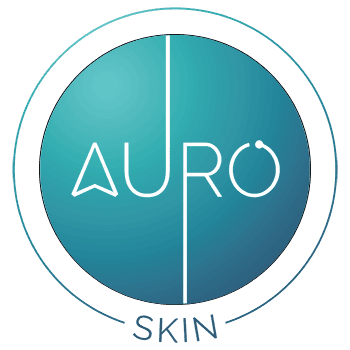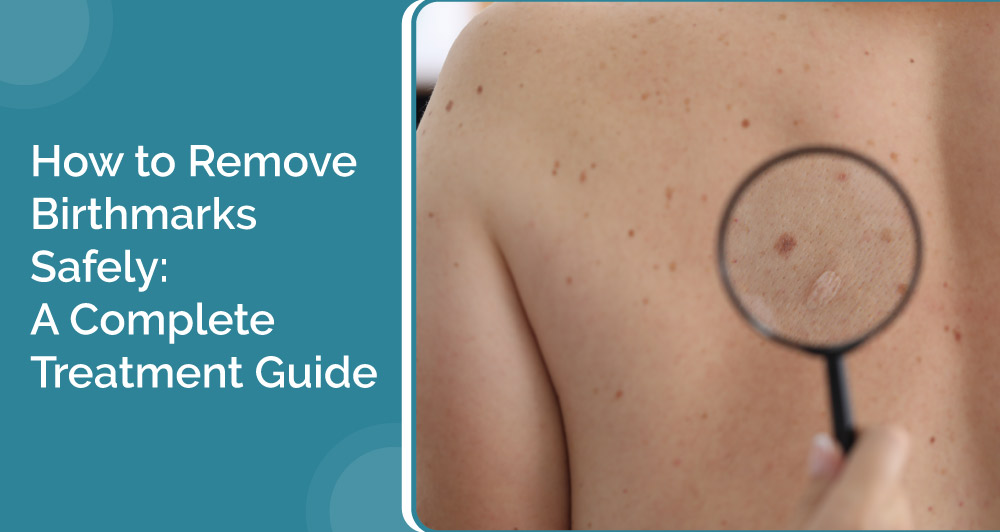April 5, 2025
Birthmarks are unique skin features that appear at birth or develop soon after in various sizes, shapes and colours. While most are harmless and add character, some people may seek birthmark removal treatment for cosmetic reasons, medical concerns, or personal comfort.
In this guide, we’ll look at different birthmark types, safe removal methods, and post-treatment care for birthmark removal so you can make an informed decision.
A] Understanding Birthmarks
Birthmarks are localised skin discolourations caused by overgrowth of pigment cells, blood vessels, or other skin structures. They can be present at birth or appear in the first few weeks of life. While most birthmarks are benign, some may require medical attention due to their appearance, growth pattern, or potential health risks.
Types of Birthmarks
1. Pigmented Birthmarks
Individuals develop these birthmarks because their skin cells produce too much melanin, which determines their skin colour. Common types are:
- Moles (Congenital Nevi): Small dark brown and black spots that appear flat or raised. While most moles are harmless, larger congenital moles may have a slightly higher risk of turning into melanoma.
- Café-au-lait Spots: These light brown oval-shaped stains that resemble coffee stains on the skin usually appear during child development.
- Mongolian Spots: These are bluish-grey skin areas on newborns’ lower back and buttocks. The condition occurs when pigment cells remain trapped in deeper skin layers and usually fade by early childhood without treatment.
2. Vascular Birthmarks
These birthmarks are caused by abnormal blood vessels near the skin’s surface. Some common types are:
- Port-Wine Stains: They are pink, red, or purple coloured marks caused by dilated capillaries and often appear on the face, neck, and limbs. Unlike other birthmarks, these do not fade and may darken or thicken with age.
- Hemangiomas: Also known as strawberry marks, these bright red bumps appear right after birth, grow rapidly during infancy, and shrink by age 5 to 10.
- Salmon Patches: These pink or red patches are common on a newborn’s forehead, eyelids and neck. They are caused by clustered blood vessels and usually fade within the first few years of life without treatment.
Knowing your birthmark type is important before seeking birth removal treatment, as different treatments work for different cases. Consult a dermatologist at our reputable skin clinic in Mumbai to determine the best approach.
B] When Should Birthmarks Be Removed?
Many birthmarks are small, but some situations call for professional removal:
- Medical Reasons: If a birthmark changes size, colour or texture, bleeds or becomes painful, a dermatologist should see it. Suspicious moles or rapidly growing hemangiomas need to be removed to prevent complications.
- Aesthetic and Emotional Reasons: Birthmarks in visible areas like the face can affect self-esteem. Many people opt for birthmark removal to look better and feel more confident.
- Physical Discomfort: Raised or large birthmarks can rub against clothing and cause irritation or infection. In these cases, removal is more comfortable.
A dermatologist can determine if removal is necessary and recommend the best course of treatment based on the type of birthmark, location and potential risks.
C] Birthmark Removal Treatments
1. Laser Therapy
Laser treatment is the standard procedure for vascular birthmarks like port-wine stains and hemangiomas. The procedure uses specific light wavelengths like pulse-dyed lasers to target and shrink abnormal blood vessels beneath the skin without damaging surrounding tissue. Most patients need multiple sessions spaced several weeks apart for the best results.
2. Cryotherapy
This freezing method is good for small, superficial pigmented birthmarks. The dermatologist will apply liquid nitrogen (-196°C) to freeze and destroy the targeted skin cells. The treated area will form a scab that will fall off in 1-2 weeks, revealing new skin underneath. Cryotherapy is best for individual marks and may require repeat treatments, but it has minimal downtime compared to other methods.
3. Chemical Peels
Chemical peels help lighten certain types of birthmarks by exfoliating the skin and promoting new cell growth. They work by applying a chemical solution that removes the top layer, helping fade the pigmented birthmarks. While it is effective for superficial marks, chemical peels may not work on deeper birthmarks. A dermatologist can determine which skin treatment is suitable based on your skin type and birthmark characteristics.
4. Topical Treatments and Medications
Prescription creams with lightening agents or beta-blockers can help fade certain pigmented birthmarks or slow hemangioma growth. While convenient, topical solutions rarely provide complete removal and are best used as additional medications with treatments. Dermatologists often combine them with other treatments for better results, especially in sensitive areas where invasive methods aren’t ideal.
5. Surgical Excision
Surgical removal is ideal for raised or deep birthmarks, especially suspicious moles. A dermatologist or plastic surgeon will numb the area, cut out the birthmark, and close the wound with stitches. This method provides tissue for biopsy when cancer screening is needed. While excision leaves a linear scar, proper post-treatment care after birthmark removal and scar management can significantly improve its appearance over time.
Each treatment has its own benefits, recovery time and side effects. A consultation with a qualified dermatologist will determine the best treatment for your birthmark type, location and personal goals.
D] Factors Affecting Cost of Birthmark Removal
- Birthmark Type & Depth: The type of your birthmark affects the cost of treatment. Vascular birthmarks like port-wine stains require multiple laser sessions, while pigmented marks may require fewer treatments.
- Technology Used: Advanced technology is more expensive. Modern pulsed-dye lasers are better for vascular marks but cost more than older technology. Clinics with advanced surgical equipment will charge more than those with basic equipment.
- Anesthesia & Aftercare: Some procedures require local anaesthesia, which can add to the treatment cost. Additionally, post-treatment care for birthmark removal, such as prescribed ointments and follow-ups, can also influence overall expenses.
- Number of Sessions: Multiple sessions are required for best results. A single mole removal may cost ₹5,000-₹15,000, while a full laser treatment for port-wine stain may need 6-10 sessions and cost ₹50,000 or more.
E] How to Minimise Risks and Ensure Safe Treatment
Safe birthmark removal treatment requires careful planning and expert guidance. Here’s how you can reduce risks:
1. Choosing the Right Specialist
Selecting a skilled dermatologist or plastic surgeon is important. Make sure they have experience in birthmark removal treatment and use advanced technology. An experienced practitioner can assess your skin type and advise on the safest way to reduce birthmark removal side effects such as scarring or pigmentation changes.
2. Following Proper Aftercare
Proper post-treatment care for birthmark removal is crucial for a quick recovery.
- Keep the treated area clean to prevent infection.
- Avoid sun exposure, as UV rays can cause pigmentation issues or delay the birthmark removal healing process.
- Use prescribed creams or ointments to soothe the skin and promote healing.
3. Understanding Your Skin Type and Treatment Suitability
Different skin types respond differently to treatments. People with darker skin tones are more prone to pigmentation changes and need special care to avoid complications. Some birthmarks respond better to certain treatments, so it’s important to consult a professional who can guide you to the best option.
Conclusion
Modern dermatology has safe and effective solutions for those wanting birthmark removal. Whether it’s for medical or cosmetic reasons, today’s treatments give natural-looking results with minimal downtime.
At Auro Skin Clinic, our dermatologists are experts in personalised birthmark removal using the latest technology and proven methods. We put your safety, comfort, and happiness at every step of your skin journey. Ready to book a consultation with our practitioners? Book now!

